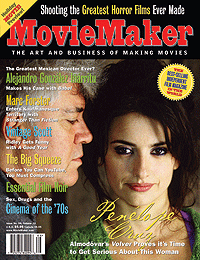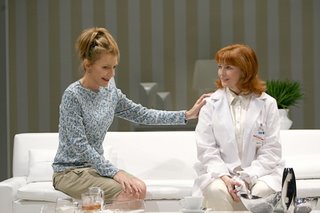Three new films this go-round, all of which happen to deal with teens and twentysomethings messing around. I wrote about the film version of
The History Boys, the Tony-iest winning play in a half-century, for the
New York Theater News' aborning website, so I probably shouldn't repeat myself. Suffice it to say that if you missed the show, you missed the essence of what made it such a thought-provoking hit, not that the movie by any means a disgrace. [With the entire cast and as much of Alan Bennett's witty script retained as possible, it couldn't be.] But changes have been made to the film which I think weaken it, and the pallid cinematography, by Andrew Dunn, is a disaster.
The real problem, I think, is that director Nicholas Hytner is more comfortable onstage than onscreen. He and Bennett collaborated successfully in both mediums on
The Madness of King George, which the cheeky and thoroughly enjoyable
The Queen put me in mind of. On his own, though, Hytner made a drab hash of
The Crucible , and
The Object of My Affection proved a fizzless romantic comedy. Opening Nov. 21,
The History Boys (Fox Searchlight Pictures) might have been better served with a new headmaster at the helm.
Candy (Thinkfilm, opened today) is likely to be overshadowed by co-star Abbie Cornish's alleged involvement with Ryan Phillippe in
le affaire Witherspoon. This would be too bad. I haven't seen the Australian actress' said-to-be-noteworthy performance in
Somersault, which is lodged somewhere in my Netflix queue. But she is faultless playing an American in
A Good Year, so much so that I didn't recognize her, though I had already seen her in this movie. Chameleon talent like this deserves to be spotted elsewhere besides the checkout tabloids.
She and Heath Ledger, continuing the career upswing begun with
Brokeback Mountain, are shatteringly good as heroin addicts whose love for each other is as toxic as their mutual habit. Addiction movies are a perennial, and a bore when they go the therapeutic route, but the writer-director, Neil Armfield (adapting a book by Luke Davies), digs deeply into their self-deceptions and delusions. That their relationship continues beyond a horrific stillbirth early on shows how crazily committed they are to each other, as they descend into prostitution, and worse. I realized how sharp the movie was when, after Candy, an art student, turns a trick, she obliges Dan, her poet boyfriend, to do the same, an entirely reasonable request that I hadn't expected to see enacted. [Ledger is nervously funny in the scene.] As a bonus, Geoffrey Rush turns up, as a self-styled professor of pharmacology who is always good for a quick fix.
I realize it's not easy to sell arthouse releases, particularly those with (gasp!) subtitles, but Strand Releasing (or maybe Film Forum, which provided me with the press notes) is giving a false impression about Emmanuelle Bercot's
Backstage, which the rep house launches on Nov. 22. "The Pop Star Diva Meets the Fan from Hell," the notes read, which is misleading; Lucie (Isild Lo Besco), who enters the orbit of singer Lauren Waks (Emmanuelle Seigner), is as much sinned against as sinner, and the whole film is very French, subtler and more reticent about the craziness of pop life than, say,
The Rose.
Inspired, perhaps, by Jennifer Jason Leigh in
Georgia, Seigner throws herself into the part of a part-Madonna, part-Debbie Harry object of adoration, singing a half-dozen ethereal songs between all the strum and drang she and Lo Besco, as an off-balance fan she basically adopts, kick up. Very incisively shot by Agnes Godard,
Backstage lacks the clawed wit of
All About Eve, which the notes reference, hopefully. And nothing in it is quite as successful as its bizarre opening sequence, where Lauren, an angel in white satin, shows up unannounced for Lucie's birthday party, trailing a reality TV camera crew behind; Lucie hides in her room, as her beloved siren tries to tempt her before the cameras. Given the envy and psychological abuse and heartache that erupt when they do meet in
Backstage, Lucie probably should have stayed put.








